|
This picture gallery
summarizes the biota found on top of boulders at Playa Estacion, Puerto
Penasco, Sonora, Mexico.
It should be used to
complete lab activity 9.4.
|
Ulva
rigida
|
|

|
 |
"Sea
lettuce"
| Division |
Chlorophyta |
| Class |
Chlorophyceae |
| Order |
Ulotrichales |
| Family |
Ulvaceae |
|
|
| Morphology |
Thin,
green, membranous blades. Usually lobed and ruffled. Up to four
inches in length. |
| Habitat |
On rocks in
the upper intertidal |
| Distribution |
Alaska to Chile
and throughout the Gulf of California |
| Other |
Competes for
space with the barnacle Chthamalus anisopoma |
|
|
Clibanarius
digueti
|
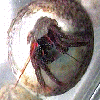 |
"Red-fingered
hermit crab"
| Phylum |
Arthropoda |
| Class |
Crustacea |
| Order |
Decapoda |
| Family |
Diogenidae |
|
| Morphology |
Red
in appearance, has an unexplained olive color phase. Light speckling
(blue) over the chelipeds and walking legs, antennaes are bright
red to orange, carapace is tan to gray. |
| Feeding |
Filter feeders
and scavengers |
| Defense |
Occupies the
shell of a dead snail |
| Reproduction |
Separate sexes.
Females brood eggs on pleopods until they hatch.
April - September, the male gives a chase over a 12 hour period
where the female is rotated, jiggled, tickled, and finally,
seduced. |
| Habitat |
In the mid and
upper intertidal zones, sandy short habitats with rock outcrops
or shell debris, mangrove swamps, under boulders and rock surfaces. |
| Distribution |
Lower Pacific
Baja and throughout the Gulf of California |
| Other |
Most common
hermit crab of the Gulf of California.
Gregarious
at low tide forming clusters of up to 700 individuals. Disperse
when the tide is changing. |
|
|
Chthamalus
anisopoma
|
|
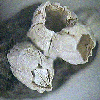
|
 |
"Small
acorn barnacle"
| Phylum |
Arthropoda |
| Class |
Crustacea |
| Order |
Thoracica |
| Family |
Chthamalidae |
|
|
| Morphology |
Volcano
shaped shell whitish to gray and composed of 6 overlapping plates
with ribbed margins. |
| Feeding |
Filter feeding
with long feathery legs passed through the water as a basket. |
| Defense |
Surrounded by
hard shelly plates |
| Reproduction |
Simultaneous,
cross-copulating hermaphrodites. Hatchlings are nauplius larvae
that develop in the plankton. |
| Habitat |
Attached to
rocks in the upper intertidal |
| Distribution |
Central California
to and throughout the Gulf of California |
| Other |
Most common
Gulf barnacle and prey for Acanthina angelica and Heliaster
kubiniji |
|
|
Ostrea
palmula
|
|
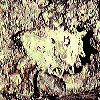
|
 |
"Palm
oyster"
| Phylum |
Mollusca |
| Class |
Pelecypoda |
| Order |
Pterioida |
| Family |
Ostreidae |
|
|
| Morphology |
White
to light blue shell. Highly variable shape. Lower valve with
fan shaped edge is cemented to rock surface. Upper valve flat
to concave. Two to three inches in diameter. |
| Feeding |
Filter feeding |
| Defense |
Thick shell
that can be held tightly shut is very difficult to prey loose
from rock. Palm-shaped lower valve protects the vulnerable edge
where the two valves meet making it very difficult to prey the
valves apart. |
| Reproduction |
Separate sexes
and spawning |
| Habitat |
On rocks and
mangrove roots in the upper intertidal |
| Distribution |
Lower Pacific
Baja, throughout the Gulf of California, south to Ecuador |
| Other |
|
|
|
Acanthina
angelica
|
|
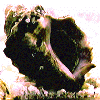
|
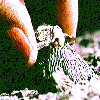 |
"Unicorn
shell"
| Phylum |
Mollusca |
| Class |
Gastropoda |
| Order |
Neogastropoda |
| Family |
Thaididae |
|
|
| Morphology |
Dull
gray, high spire with large nodes below the suture; large spine
on outer aperture, purplish-brown to glossy white interior. |
| Feeding |
Often occur
in large clumps while feeding on barnacles. Apertural spine
possibly used to pry open the opercular plates of acorn barnacles |
| Defense |
Thick shell |
| Reproduction |
Fertilization
is internal - females deposit egg capsules under rocks. |
| Habitat |
On rocks in
mid to high intertidal zone on or near barnacles. |
| Distribution |
Gulf of California,
Puerto Penasco, Sonora, Mexico. |
| Other |
|
|
|
Serpulorbis
margaritaceus
|
|
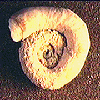
|
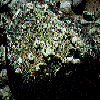 |
"Large
worm snail"
| Phylum |
Mollusca |
| Class |
Gastropoda |
| Order |
Mesogastropoda |
| Family |
Vermetidae |
|
|
| Morphology |
Pale
brownish tubes wound into a flat spiral. Has no trapdoor (operculum).
Diameter 3 inches. |
| Feeding |
Fashions a net
of mucus strings which traps debris and tiny animals. They may
float free in water or be stretched across a crack between 2
rocks, anchored to the snail by only a string. When full, the
snail pulls in and eats net and all. |
| Defense |
Thick shell
with small opening |
| Reproduction |
Spawners |
| Habitat |
Intertidally
on rocks or shells. |
| Distribution |
Gulf of California
to Southern Mexico. |
| Other |
One
of a small group of snails that lives cemented to one spot. |
|
|










